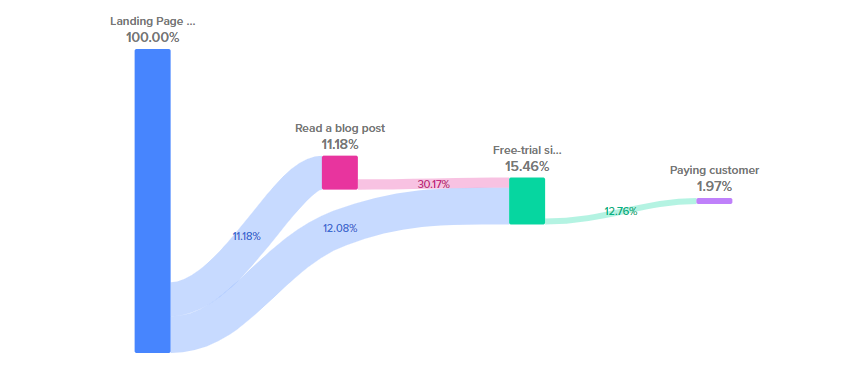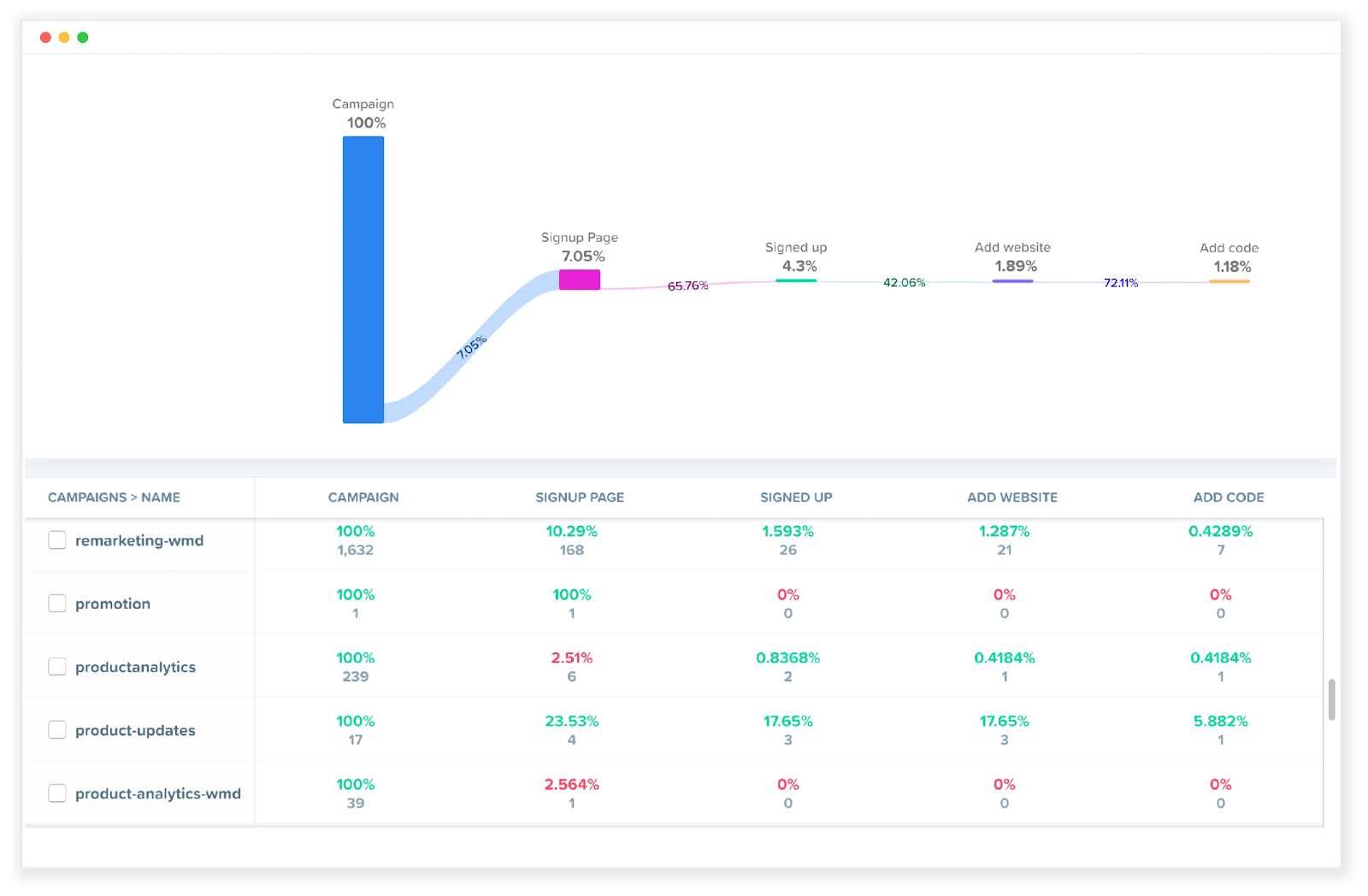Every click and interaction shapes the digital customer journey. This path shows how well your brand delivers a smooth digital experience. It's vital for standing out in today's fast-paced digital marketing world.
To excel, you must know and predict your customers' path from first becoming aware to becoming loyal fans. The digital experience you provide is where you battle for their attention.
With smart marketing, you lead prospects on a journey that surpasses their expectations, securing their long-term engagement.
What Is the Digital Customer Journey?
The digital customer journey is the customer journey in a digital setting. Digital customer journeys span touchpoints across social media, search engines, websites, apps, online purchases, and beyond to brand ambassadorship.
Each interaction you have with a brand is like a new chapter in a story. This journey starts with the first spark of interest and continues to the purchase and beyond.

We use customer journey analytics to track every phase, gathering crucial data along the way.
Now, technology brings a new twist to creating a digital customer journey map. It’s like drawing a detailed map based on careful analysis of customer behavior. Your online actions, from browsing a website to chatting with customer service, are all noted.
- Customer Journey Mapping: It’s the cartography of commerce, detailing each step you take, and each pivot brands must make to guide you seamlessly through the digital space.
- Customer Touchpoint: These are the moments that matter, where you, the customer, and the brand engage, presenting opportunities to impress, address concerns, and forge deeper connections.
- Digital Touchpoint: It's the digital equivalent of a handshake, where you meet the brand online, whether it be through a social media ad, an email offer, or a chatbot conversation.
By analyzing the customer journey, businesses improve their services. They anticipate your needs and remove obstacles, making your experience better tailored to you. Your opinions guide them, highlighting areas for better service and more impactful connections.
Your experience on the digital customer journey should be smooth, natural, and personalized. It’s about combining data with personal touch to make your journey feel designed just for you. This blend of technology and personalization is key to customer happiness and business success.
Digital vs. Offline Customer Journey Differences
 Source: ThinkOwl
Source: ThinkOwl
Today's marketplace is complex. Knowing how digital customers differ from those offline is key for a good digital marketing plan. In the online world, digital paths offer quick and easy options.
These are hard for physical stores to compete with. Customers expect fast answers via live chat, smooth digital browsing, and connections through social media.
Here are key differences between digital and offline customer journeys:
- Instantaneity and Self-service: In the digital space, customers want quick info and to solve problems on their own. They use FAQs, chatbots, or forums long before they visit a store.
- Social Media Interaction: Social media is crucial for talking to customers. Companies can build a community, respond fast, and show their brand's personality live.
- Personalization: Digital allows businesses to make personal experiences for many customers, using lots of data from online interactions.
- Live Chat Support: Live chat gives online shopping a personal touch. It offers fast, personalized support, blending online ease with offline warmth.
- Data-Driven Insight: Online, businesses can collect and analyze customer data easily. This leads to smarter marketing automation, hard to do offline.
A strong digital marketing strategy is essential these days. Understanding online versus offline journeys can bridge gaps. Make sure digital customers get what they expect. Improve your strategy, make every interaction matter, and deepen customer loyalty through every online touchpoint.
What Are the 5 Parts of the Customer Journey?

Source: The Chartered Institute of Marketing
Starting a successful digital journey means knowing the steps your customers take. From the first spark of interest to becoming true supporters. We'll explore the five main stages of the customer journey. Here, your efforts in content marketing, email marketing, and customer relations come together. They work to create great experiences for your customers.
- Awareness Stage: At this initial phase, content marketing is key. Your audience is searching for info, maybe not even knowing they need what you offer. By sharing valuable content, you grab their interest. This starts their engagement with your brand.
- Consideration Stage: Now, your potential customer is looking at their choices. Offering free trials, detailed info about your product, and showcasing positive reviews are important. This is the time when connecting with them can really pay off.
- Purchase Stage: All your hard work leads to this point – making the sale. This is when engagement peaks as the customer is ready to buy. The process should be easy and smooth.
- Retention Stage: After buying, the customer’s experience with what you sell influences their next steps. Good support and a way to give real feedback are crucial. They help make your product or service better and keep customers loyal.
- Advocacy Stage: Lastly, the loyalty stage deepens the connection between your brand and the customer. By offering special rewards, deals, and smart email marketing, you can keep this bond strong. Happy customers can become champions for your brand.
Being attentive to customer feedback and growing their interest strengthens your brand at every step. It shapes a digital journey that not only draws in customers but also honors their entire journey with your brand. This is key to a plan that keeps customers engaged and happy, at all journey stages.
Digital Customer Journey Examples
Think about creating a digital plan for your ideal potential customer. This persona helps you understand and meet their needs. Imagine catching a smart shopper's attention with a custom ad. This is their first step in the digital customer journey.
When interest sparks action, your shopper looks for the best deals. They compare features, prices, and reviews. Your job is to offer helpful content. Use tools to remember what they like. This will make them happy and more likely to buy.
- Purchase Stage: A smooth checkout experience is key. Use easy payment options to keep them from leaving.
- Post-Purchase: Now, focus on customer support to build a strong bond with your brand.
- Customer Loyalty: Show your customers they matter after buying. This prepares them to stay loyal and recommend you.
Don't just focus on making a sale. Work on keeping loyalty. Send thank-you notes, ask for feedback, or offer loyalty perks. This can turn happy customers into your biggest supporters. When they buy again and tell others about you, you've achieved the best loyalty level.
Use Woopra for Customer Journey Analytics
Woopra helps you really understand your customers' online journey. This improves the overall customer experience. Journey analytics go beyond just following a path. They let us dive deep into how customers interact and what shapes their journey.

With Woopra's tools, you can see these details and make every step better for your customers. This way, your business can keep up with changes in what customers want and do.
Managing customer experiences combines data with smart action. Woopra uses AI to show patterns and trends as they happen. This means you can guess what customers will want next. With this kind of insight, your marketing hits the mark every time.
Woopra makes sure your customer service is top-notch, quickly solving problems and making customers happy.
Keeping customers loyal takes more work than before. Woopra lets you create experiences that go beyond what customers expect. This builds trust and keeps them coming back. By using Woopra, every move you make is informed by deep customer understanding. It makes sure every interaction is spot on. For businesses that put customers first, Woopra is a game-changer.


